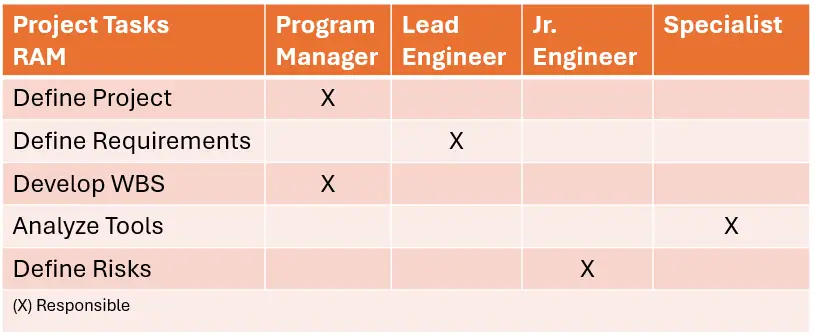In the realm of project management, effective communication and clearly defined roles are crucial for success. Two widely used tools to achieve this clarity are the Responsibility Assignment Matrix (RAM) and the Responsible, Accountable, Consulted, and Informed (RACI) Matrix. While both serve the purpose of delineating responsibilities within a project, they differ in their approach and application.
Responsibility Assignment Matrix (RAM):
The Responsibility Assignment Matrix, often known simply as the RAM, is a visual representation that connects project tasks with the individuals or roles responsible for their execution. It provides a comprehensive overview of project responsibilities, helping to identify gaps or overlaps in roles. Key Features:
- Task-Centric Focus: RAM primarily centers around tasks or activities. It lays out who is responsible for what task, making it a valuable tool for project managers to ensure that all necessary activities are accounted for.
- Detailed and Specific: RAM allows for a granular breakdown of responsibilities. It can go beyond project phases and delve into individual tasks, providing a more detailed perspective on roles and assignments.
- Limited to Responsibility: RAM generally focuses on the “R” (Responsible) aspect of project roles, emphasizing the assignment of tasks rather than detailing the broader aspects of communication and decision-making.
Responsible, Accountable, Consulted, and Informed (RACI) Matrix:
The RACI Matrix, on the other hand, takes a broader approach by encompassing not only responsibility but also the concepts of accountability, consultation, and information dissemination. It is a more holistic tool that ensures a well-rounded understanding of who is involved in key project decisions and communications. Key Features:
1 Comprehensive Role Definition: RACI incorporates four key roles:
-
- Responsible (R): The person or team responsible for the task’s execution.
- Accountable (A): The ultimate decision-maker, the one who ensures the task is completed and meets the required standards.
- Consulted (C): Individuals or teams that provide input and feedback before decisions are made.
- Informed (I): Those who are kept in the loop, notified of decisions and outcomes but do not play a direct role in task execution.
2 Decision-Making Clarity: The inclusion of the ‘Accountable’ role in RACI brings clarity to decision-making processes. This ensures that there is a designated party responsible for the final outcome of each task or project phase.
3 Communication Emphasis: RACI highlights the importance of effective communication by explicitly designating roles related to consultation and information sharing. This is particularly crucial in complex projects with multiple stakeholders.
Choosing the Right Tool:
The choice between a Responsibility Assignment Matrix and a RACI Matrix depends on the project’s complexity, the need for detailed task-oriented breakdowns, and the emphasis on communication and decision-making clarity. While RAM excels in offering a detailed task-centric view, the RACI Matrix provides a more comprehensive understanding of project roles, ensuring that responsibilities, accountabilities, consultations, and communications are clearly defined.
Conclusion
In conclusion, whether you opt for a RAM or a RACI Matrix, the key is to choose the tool that aligns best with your project’s goals and complexity, fostering a transparent and efficient workflow for all stakeholders involved.


